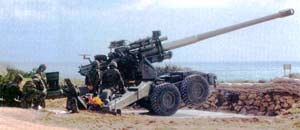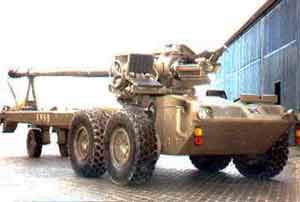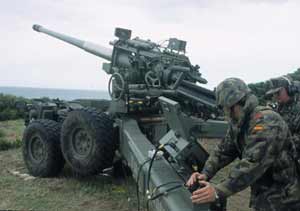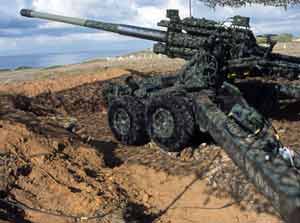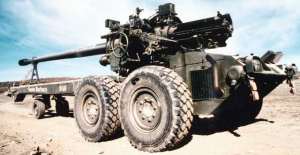| Designation: | APU SBT SIAC |
 |
|---|---|---|
| Manufacturer: | General Dynamics Santa Barbara Sistemas | |
| Product type: | Weapons & Weapon Systems | |
| Name: | Towed howitzer |
The 155/52 APU SBT is a howitzer developed with Spanish technology, for fire support and protection missions with high performance, low maintenance cost and a reduced crew. GDSBS developed the 155/52 APU SBT Howitzer in the framework of the Joint Ballistic Agreements. Its design follows the most modern concepts in large caliber artillery worldwide.
The 155/52 APU SBT howitzer is at the cutting edge of large caliber artillery. Its features guarantee its effectiveness and operability as a result of: high mobility cross-country, inertial navigation, ballistic computing, high rate of fire, range over 40 km with base bleed ammunition, simple operation, easy to maintain. It can be used as coastal or field artillery and it can be easily integrated into different Command & Control Systems.
The 155/52 APU SBT Howitzer, with 155 mm caliber and bi-mast mount, with firing angles: - 40º and +30º in azimuth and -5º and +68º in elevation Length in autonomous/firing modes: 10,664 mm/13,995 mm Height in autonomous mode: 2,230 mm Width: 2,820 mm Weight: 13,500 kg
The 155/52 APU SBT howitzer is equipped with a diesel engine supplying hydraulic power to the drive wheels, assuring a high cross-country mobility. Features: Diesel engine. Maximum power: 106 HP. Transmission: Hydraulic. Maximum speed: 18 Km/h. Maximum slope: 30 %.
Inertial Navigation. Ballistic Computing. On-Board Computer. Automatic Laying and Firing Systems. Command & Control Interface. Hydraulic Ramming System. Automatic Primer Magazine. Breech Automatic System.
Caliber 155 mm. Barrel length: 8120 mm. Chamber: 23 liters. 3 stage muzzle brake. Single block autoffretaged barrel. Screw breech. Plastic pad obturator. Automatic opening breech Operation. Oleo-pneumatic counter-recoil mechanism. Brake: Recoil and counter-recoil hydraulic rod with absorber.
Based on the experience in the design and development of the 155 mm SB 155/39 towed howitzer, which never entered production, the now General Dynamics Santa Bárbara Sistemas, in association with other defence equipment manufacturers, developed a new 155 mm/52 calibre system called the 155/52 APU SBT howitzer.
The first prototype was completed in December 1997 and by May 1998 had fired over 170 rounds of 155 mm ammunition including Extended Range Full Bore and Extended Range Full Bore - Base Bleed.
Early in 2001, it was stated that the Spanish Army had begun forming a Mobile Coastal Artillery Group with the first batch of six 155/52 APU SBT howitzers supplied by General Dynamics Santa Bárbara Sistemas.
The 155/52 APU SBT Coastal Howitzer C2 (command and control) system will co-ordinate data from coastal defence tracking radars to enhance target engagement capability.
In mid-2005 the Spanish Ministry of Defence (MoD) signed a contract with General Dynamics Santa Bárbara Sistemas worth EUR189.5 million for the supply of 70 155 mm 155/52 APU SBT howitzers for the Spanish Army.
The Spanish Army already operates 12 General Dynamics Santa Bárbara Sistemas 155 mm/52 APU SBT. Of these, four (V06) are in the field artillery role and eight (VO7) are integrated into a coastal artillery group.
In the designation '52' represents the calibre length of the 155 mm barrel and 'APU' stands for Auxiliary Power Unit. The latter allows the system to travel on roads up to a maximum speed of 18 km/h, as well as moving around the battery position without its prime mover.
These weapons are a further development of the Spanish SITECSA 155 mm 45 calibre weapon developed some years ago in two configurations, standard towed and fitted with an auxiliary power unit (APU).
Under the terms of this new contract the 12 existing weapons will be overhauled and rebuilt to a new common enhanced standard with the complete weapon system being called the Obus 155/52 version V07.
The contract includes the development of a new version of the howitzer named SIAC (Sistema Integrado de Artilleria de Campaña or Field Artillery Integrated System) with improved mobility and new capabilities including C2 integration and a more complete truck integration.
The 70 brand-new weapons comprised four units delivered late in 2006 which correspond to the V07 configuration and the remaining 66 will be built to the new SIAC standard. This will bring the total Spanish Army fleet up to a total of 82 systems (16 V07 and 66 SIAC).
Of these, 66 will be deployed with the field artillery which will be organised into four groups each of 16 weapons with eight weapons being allocated to a battery. Each battery consists of two sections each of four weapons. The other two units will be used for training purposes.
The 16 V07 will be used by the coastal artillery that will have two groups each of eight which will be operated by two batteries each of four weapons. These are deployed in Southern Spain to defend the Straits of Gibraltar.
The first prototype of the complete weapon to the latest SIAC V07 production build standard was completed late in 2006 and will be evaluated through to the end of 2008.
This will be followed by pre-production systems with the main production run of SIAC 07 starting in 2009 and running through 2013 at the rate of 13 to 14 weapons a year.
The major contract also covers the supply of the on board digital navigation and automatic laying system, Thales PR4G communications system (which will be supplied by the Spanish company of Amper) and Italian IVECO Defence Vehicles (6 × 6) cross-country trucks. In addition the contract covers the complete logistical in service support. The IVECO Defence Vehicles (6 × 6) prime mover is referred to as the Vehiculo Tractor (VET) and these will be delivered at the rate of 16 a year from late 2009.
VET is provided with a forward control cab and an additional fully enclosed cabin to the rear for the remainder of the gun crew. Space is also provided for a quantity of ready use 155 mm ammunition (projectiles, charges and fuzes). According to General Dynamics Santa Barbara Sistemas the on board computerised fire-control system coupled to an inertial navigation system will provide for greater accuracy as well as reducing the time taken to come in and be taken out of action. This will enhance its survivability to counter battery fire.
It is understood that Colombia placed an order for 15 General Dynamics Santa Barbara Sistemas 155 mm 155/52 APU SBT howitzers.
The General Dynamics Santa Bárbara Sistemas 155 mm SBT 155/52 APU SBT howitzer has a conventional split trail carriage and when deployed in the firing position is supported on a circular firing platform mounted under the carriage and on the two trails, each of which is provided with a spade and a small wheel. The latter is used to assist in bringing the weapon into action.
The carriage has four wheels and mounted on the front of the carriage is the 106 hp (78 kW) diesel auxiliary power unit (APU) with the driver being seated on the left side. The alternator and batteries are also located on the APU.
The suspension is of the walking beam type and the diesel APU supplies hydraulic power to the four drive wheels to enable the weapon to be driven across country under its own power. Maximum road speed is 18 km/h. In addition to providing power for the four main road wheels the APU also provides power for raising and lowering of the auxiliary wheels, opening of the trails and operation of the firing platform and aiming systems.
When travelling, the upper part of the system, complete with 155 mm/52 calibre ordnance, is traversed through 180° and locked in position over the closed trails.
The 155 mm/52 calibre autofrettaged ordnance has a 23 litre chamber and is fitted with a three part slotted muzzle brake with an efficiency of 35 per cent. The screw breech mechanism is of the screw type with a plastic pad obturator and upon recoil opens automatically. The ordnance meets the NATO Joint Ballistic MoU. The firing system includes a detonation and primer magazine system with 10 M82 type primers in a drum type magazine.
The counter recoil system is of the oleo-pneumatic type. Recoil system is of the hydraulic rod type with an absorber. Elevation and traverse is hydraulic with the layer being seated on the left side of the carriage.
To enable a high rate of fire to be achieved and load the weapon at high angles of elevation, a loading tray and hydraulic projectile rammer are fitted as standard.
According to General Dynamics Santa Bárbara Sistemas, the 155 mm 155/52 APU SBT howitzer has a maximum range of 31.7 km firing standard projectiles and 41 km firing base bleed projectiles. Standard bagged charges or modular artillery charge systems can be used with this equipment. Standard equipment on the weapon includes a flick rammer, muzzle velocity measuring radar, ten round primer magazine, round counter, recoil meter and chamber temperature detector.
The software used in these new systems will be the same as that used in the fire-control systems used with the Spanish Army's 105 mm Light Guns and 155 mm M109E5 self-propelled artillery systems.
Under a separate contract the company has also been awarded a contract for the design and development of a new family of 155 mm ammunition for use with these 155 mm/52 calibre artillery systems.
Optional equipment includes a hydraulic rammer, automatic breech opening system, recoil meter, navigation system and various types of laying system. The following aiming devices are fitted:
- Telescope M137 (magnification ×4)
- Telescope mount M171
- Telescope square M17
- Direct aiming sight M138 (magnification ×4)
- Sight mounting M172
- Sight square M18
- Muzzle-centring device SKS155
The latest Spanish Army systems are fitted with a Digital Navigation Aiming and Pointing System (DINAPS) which is also being installed in Spanish Army 105 mm L118/L119 Light Guns (56 units) and M109A5E 155 mm self-propelled artillery system (96 units).
DINAPS is a modular system that combines a hybrid (inertial and global positioning system) navigation system, muzzle velocity radar (MVR) and a navigation and ballistic software which is able to connect to the Spanish Army command and control system (C2).
The system uses NABK (NATO Ballistic Kernel) as a core for ballistics using a variety of projectiles to enable the weapon to engage stationary and moving targets with a high first round hit probability.
The inertial navigation unit determines the elevation and northing angles of a gun barrel and corrects automatically for any variation in projectile, charge and meteorology.
The 155 mm 155/52 APU SBT is also fitted with an Automatic Gun Laying System (AGLS) which is used in conjunction with DINAPS to automatically lay the weapon onto the target.
In addition to being used with towed and SP weapons it can also be used with rocket launchers. The software installed in DINAPS allows the system to be used with different command and control/communications systems.
DINAPS + AGLS has already been type classified for the GDSBS 155 mm/52 calibre artillery systems model V07 and SIAC.
|
||||||||||||||||||||
|
||||||||||||||||||||


